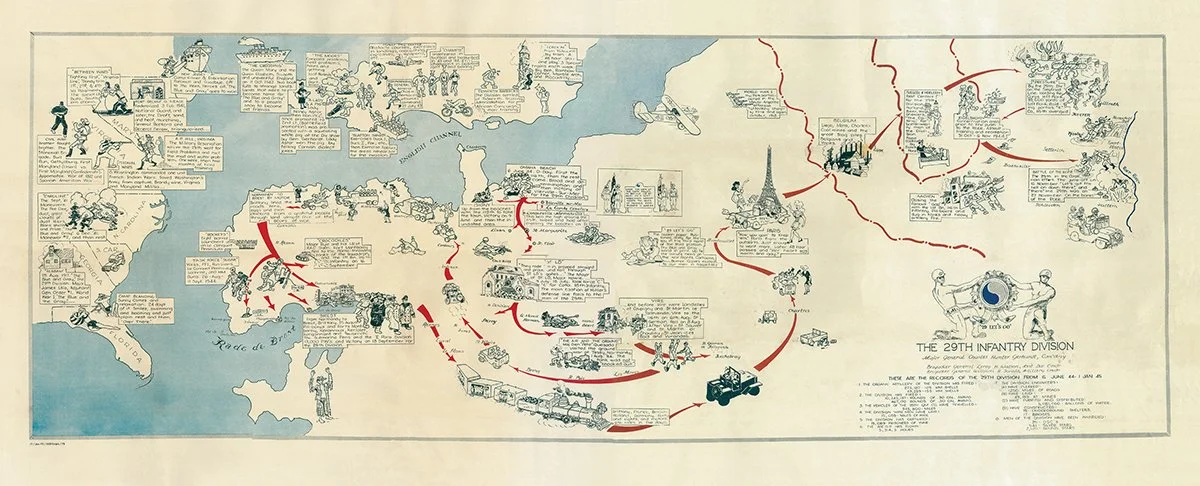29th Infantry Division - Blue and Gray
Activated 3 Feb 1941 • Entered Combat 6 June 1944 D-Day • Days of Combat 242 • Casualties 20,620
Commanding General
Maj. Gen. Milton A. Reckord Feb 41
Maj. Gen. Leonard T. Gerow Feb 42
Maj. Gen. Charles H. Gerhardt Jul 43 - inactivation
Campaigns
Normandy Jun 44 - Jul 44
Northern France Jul 44 - Sep 44
Rhineland Sep 44 - Mar 45
Central Europe Mar 45 - May 45
Division Chronicle
The 29th Infantry Division, known as the "Blue and Gray division" played a pivotal role in World War II and is remembered for its heroic actions and sacrifices on the battlefields of Europe. A National Guard unit comprised of soldiers primarily from Maryland and Virginia, the division distinguished itself through its remarkable achievements and unwavering determination throughout the war.
Between April and September 1942, the 29th Division underwent intensive training and preparation for combat at a number of Army training camps on the east coast including Camp A.P. Hill in Virginia and Camp Blanding, Florida. In late September the division embarked for Scotland on the RMS Queen Mary and RMS Queen Elizabeth. From October 1942 to June 1944 the division trained in Scotland and England for the cross-channel invasion.
Teamed with the 1st Division, a regiment of the 29th (116th Infantry) was in the first assault wave to hit the beaches at Normandy on D-day, June 6, 1944. Landing on Omaha Beach on the same day in the face of intense enemy fire, the rest of the division soon secured the bluff tops and occupied Isigny, 9 June. The Division cut across the Elle River and advanced slowly toward St. Lo, fighting bitterly in the Normandy hedge rows. Despite suffering heavy casualties due to fierce German resistance and obstacles, the division persevered and managed to secure their objectives.
As the division pushed inland, they faced continued resistance from German forces. In July 1944 they played a crucial role in the capture of the strategic city of Saint-Lô, a vital objective in the Allied campaign. After taking St. Lo, the 29th joined in the battle for Vire, capturing that strongly held city on August 7. Turning west, the 29th took part in the assault on Brest from August 25 to September 18, 1944.
Top of Form
After a short rest, the Division moved to defensive positions along the Teveren-Geilenkirchen line in Germany and maintained those positions through October. In mid-October the 116th Infantry took part in the fighting at the Aachen Gap. On November 16 the Division began its drive to the Roer, blasting its way through Siersdorf, Setterich, Durboslar, and Bettendorf, and reaching the Roer by the end of the month. Heavy fighting reduced Julich Sportplatz and the Hasenfeld Gut on December 8.
From December 8, 1944 to February 23, 1945, the Division held defensive positions along the Roer and prepared for the offensive. The attack jumped off across the Roer, February 23, and carried the Division through Julich, Broich, Immerath, and Titz, to Munchen-Gladbach, March 1, 1945. The Division was out of combat in March. In early April the 116th Infantry helped mop up in the Ruhr area. On April 19, 1945 the Division pushed to the Elbe and held defensive positions until May 4. Meanwhile, the 175th Infantry cleared the Klotze Forest. After VE-day, the division was on military government duty in the Bremen enclave.Bottom of Form
Date Activated is the date the division was activated or inducted into federal service (national guard units).
Casualties are number of killed, wounded in action, captured, and missing.
The dates after the campaign name are the dates of the campaign not of the division.
The Army Almanac: A Book of Facts Concerning the Army of the United States; , U.S. Government Printing Office. Army Battle Casualties and Nonbattle Deaths in World War II, Final Report, 1 December 1941 - 31 December 1946. US Army Center of Military History at http://www.history.army.mil/ Various divisional histories

